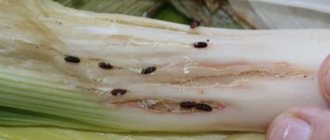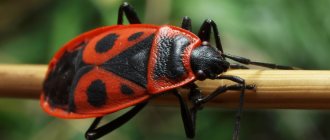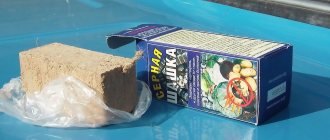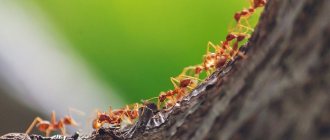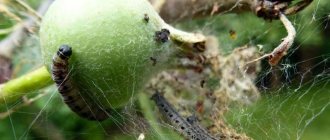Mealybugs on orchids are not very mobile pests. They are tiny and resemble little cotton balls. On orchids they hide in the corners of leaves and in dormant buds.
They suck the juice out of plants. The leaves of attacked flowers turn yellow and fall, the plant stops growing. As a result, even large specimens of orchids die after some time. We'll tell you how to deal with it and how to treat the plant.
Mealybug on an orchid
What the mealybug is afraid of - folk methods of control
If a mealybug is detected in time, there will be no difficulties in dealing with this parasite on indoor plants using chemicals and folk remedies. A popular killer mixture for mealybugs from the arsenal of folk craftsmen is green soap, and this product is prepared from an alcohol tincture of calendula with the addition of laundry soap shavings. This product can be replaced with ordinary liquid soap, which is used to wipe the leaves of plants at intervals of 3-5 days.
fight against mealybugs - in the photo
Soap solutions and emulsions are not suitable for indoor plants with fuzzy leaves, but they are good when mealybugs have settled on a cactus, streptocarpus or other crops with smooth leaf blades. If a harmful worm is found on violets, gloxinias and similar plants, you should use other means:
- Infusion of shag;
- Decoction of cyclamen rhizomes;
- Alcohol tincture from horsetail;
- Water infusion of garlic.
These products can be applied using a sprayer, but in some cases you will have to additionally treat the plants with cotton swabs soaked in them.
When a pest such as a mealybug appears, traditional methods of control should be used for several months in a row, and not only affected plants should be treated, but also healthy ones. Regular sanitary treatment of indoor plants will help to effectively combat the pest - the gardener will have to wash the green pets weekly with soapy water, trim and carefully burn the leaves on which colonies of parasites are found.
Control measures at home
There are two ways to remove harmful insects: mechanically and by treating with drugs (you can treat with either purchased or home-made products).
More about mechanical removal
As soon as you find a scale insect on an orchid, immediately follow the following algorithm:
- remove the affected areas of the flower;
- prepare a soap solution (from laundry or green soap);
- soak a cloth in the prepared solution and wipe the green part of the plant, removing visible hairy lice from it;
- wipe with a cotton swab in hard-to-reach places (especially in the leaf sinuses);
- Give the orchid a good shower, but before that, check to see if there are still any mealybugs left to avoid getting them into the root system. (Lice can also suck sap from the roots.);
- remove the flower from the soil and thoroughly rinse the root system (it is advisable to carry out this procedure several times).
TIP: It is not only the plant that needs to be treated, but also the location of the flower pot.
Watch a video about removing mealybugs from an orchid:
Chemical means of destruction
This is a very tenacious insect, so often mechanical treatment alone may not be enough. Even if just one larva remains, it can breed a new generation of lice. Therefore, we recommend not to take risks and adopt one of the proposed means:
- “Fitoverm” (Kills both adults and larvae, causing them complete paralysis).
- “Bankol” (Comfortable for use due to the complete absence of odor, the effect is observed on the second or third day after use).
- “Aktara” (A fairly powerful product that can destroy the pest in 4 hours. Experienced gardeners recommend adding the drug to irrigation water. Then the protective effect will last up to sixty days).
- “Mospilan” (A characteristic feature is the ability to destroy not only larvae, but even oviposition).
Whatever one may say, any chemical is a toxin, albeit sometimes a weak one. Therefore, you should only use the products listed above with gloves. After use, ventilate the room, wash your hands and face thoroughly with soap and running water, rinse your mouth with clean water, and in case of contact with eyes, rinse immediately with running water.
To get the full effect, after treating the orchid with chemicals, put a plastic bag on the flower.
Traditional methods
Among the folk remedies the following can be distinguished:
- Chamomile decoction. To prepare it, take 200 grams of flowers and the green part of chamomile, pour it all with one liter of boiling water and put it in a dark place for half a day. After this time, strain the tincture and add another three liters of liquid.
- Garlic tincture. Pour boiling water over 5-6 cloves of garlic and leave for about twelve hours. Strain and spray the resulting mixture onto the orchid.
- Onion broth. Boil the peeled onion for several minutes, cool the water and then strain.
- Pepper tincture. Pour 50 grams of hot pepper into half a liter of boiling water (it’s better to boil for about five minutes), set aside and then strain.
Some experts advise treating orchid leaf blades with alcohol. But this must be done with special caution, since the evaporating alcohol burns the leaves.
All drugs form an invisible film on the surface of the plant, interfering with the process of photosynthesis. Therefore, wipe the flower after treatment with a cotton swab dipped in clean water. Any treatment must be carried out at least twice with an interval of one week.
Which plants are most often affected and why they are dangerous?
Most often, the hairy louse attacks azalea, amaryllis, asparagus, anthurium, grapes, gerbera, hibiscus, dracaena, cactus, Kalanchoe, camellia, croton, monstera, oleander, palm, pachystachys, fuchsia and philodendron. Sticky leaves appear on dracaena, buds become deformed on orchids, and yellow leaves appear on violets.
The parasite is dangerous to plants because it destroys their root system, leaves and twigs, leaving white traces of its activity on their surface. Insects also poison the soil where the seedlings grow and turn the habitat of the planted crop into hell.
Plant species
Developmental cycle of mealybugs
- Egg. Females lay eggs in a felt cocoon. Some species are viviparous - producing live larvae.
- The larvae move quickly, conquering new spaces; they are called “vagrants”. In some species, they are inactive. There is no gender distribution.
- Imago. After molting, strays become adults, females and males.
Remedies for mealybugs (preparations)
Most often, insecticides are used to control mealybugs. It is advisable to spray in the fresh air. To do this, you can go outside or onto the balcony. If the drugs can be used indoors, it still needs to be ventilated. Even low-hazard chemicals require the use of protective equipment. During use, be sure to follow the included instructions. To avoid insects getting used to the poison, the drugs can be alternated.
The following remedies are often used against mealybugs:
- Admiral. A composition based on pyriroxifene, which has a hormonal effect on pests. After treatment, adult individuals become sterile, and the developmental stages of the larvae are disrupted, leading to their death.
- Aktara. An economical product based on thiamethoxam. It works in any external conditions, does not penetrate into fruits, but only into foliage, affecting insects during feeding. The popularity of the drug is associated not only with its effectiveness, but also with the absence of a strong odor. It should not be mixed with alkaline substances.
- Actellik. Product based on pirimiphos-methyl. It poisons scale insects by entering their bodies with plant sap. The drug is considered strong and effective, but has a persistent pungent odor and is not suitable for preventive treatments.
- Apple. A hormonal drug based on buprofezin. Sold in powder form.
- Bankol. Product based on bensultap. Affects insects during feeding or direct contact with the drug. Low toxicity, not washed off by rain and works well even in the heat. But it cannot be used during flowering, and the effect lasts only about two weeks.
- Biotlin. Systemic product based on imidacloprid. It has a quick effect and is not addictive to pests.
- Bitoxibacillin. It is created on the basis of a strain of special bacteria and is considered a bio-agent that affects insects through their nutrition. It can be used at any stage of the plant’s life, does not accumulate in its fruits and is considered safe for humans within the established consumption standards.
- Vertimek. A drug based on abamectin. It is not toxic to plants, although it is very dangerous for bees, and has a long-lasting (about a month) effect.
- Duntop. The drug is in the form of granules. Synonyms - Apache, Ponche.
- Inta-vir. Contains an analogue of cypermethrin, a natural toxic substance. Not suitable for preventative treatments due to high levels of toxicity. It should not be used during flowering. In addition, the substance should not enter water bodies or even sewers.
- Spark Double effect. Low-toxic drug suitable for indoor plants. Includes poisons cypermethrin and permethrin, as well as anti-stress components to enhance plant resistance.
- Calypso. The product for treating leaves is almost odorless. The main substance is thiacloprid. Sold in the form of emulsions or suspensions, it adheres well to foliage. It can be used even at home, but be sure to use a respirator.
- Karbofos. A product based on malaoxone. Resistant to high temperatures. Has an unpleasant smell. The drug should not be used during flowering, nor should solutions be stored.
- Commander. The main substance is imidacloprid. It has a long shelf life and is not afraid of heat. It enters the affected plants through roots, shoots and leaves and blocks the nervous system of insects. Treatments are carried out no more than once every 15 days. The solution cannot be stored. The best time for use is during the growing season.
- Confidant. Created on the basis of imidacloprid. It is a concentrated emulsion that can act for about 6 weeks. The composition is odorless and does not harm the green parts of plants. Features a low consumption rate.
- Mospilan. The main substance is acetamiprid. It is a systemic drug, does not cause addiction among pests, is consumed in small doses and is not afraid of high temperatures. The validity period is about 3 weeks. Considered low toxic.
- Tanrek. A product based on imidacloprid. Effective for 4 weeks. It almost does not penetrate into the fruit and does not have a pungent odor. It is considered stable even in soil.
- Fitoverm. A bio-product based on aversectin, a substance synthesized from soil fungi. It is economical in consumption, but requires frequent repetition of treatments (up to 5 per season) and is not considered ineffective in cases of severe pest damage. It does not pollute nature, but is considered poisonous to bees, so it should not be used directly during flowering.
Preventative treatment
To prevent scale insects from settling on plants, you must remember the following preventive measures:
- Carry out regular inspection of the bushes, paying special attention to leaf axils, the underside of leaves and buds.
- Trim or tear off dried stems, buds, leaf blades and branches in a timely manner, as they can attract harmful insects.
- Water crops properly. Watering should be systematic and sufficient.
- It is very useful for indoor plants to have a warm shower.
- Any new indoor flower is quarantined for at least 15 days. To do this, it is removed away from other house plants and must be sprayed with an insecticidal solution for preventive purposes.
The most favorable environment for scale insects is warmth (above 25 degrees) and high air humidity. If your flower is grown in such conditions, then you need to inspect it regularly to identify insects.
Mealybug - how to fight on indoor plants, effective drugs
In 90% of cases, the fight against a miniature parasite begins with a thorough cleaning of the plants mechanically, then, if the insects survive, they are treated with chemicals - this approach is correct, but sometimes when removed, the mealybug can hide in the folds of clothing, on gloves or tools, and then get on healthy plants, so the grower should be extremely careful here.
Mealybug on an orchid - pictured
- Aktara - used for external application and for adding to the soil, while the drug acts directly on the pest as a contact substance and causes its death in the first day. The active substance of the drug is absorbed into the plant, making it poisonous to the pest;
- Tanrek is a contact and food poison that destroys parasites equally well when it comes into contact with the body or when it penetrates the digestive tract with the juice of the affected crop. Tanrek for mealybug is used up to 4 times;
- Fitoverm is an organic poisonous drug that acts on pests when it enters the digestive tract; it is recommended to use Fitoverm against mealybugs at least 4 times;
- Confidor is an analogue of Tanrek, used for watering and external application; when it enters the pest’s stomach with plant juice, the product causes paralysis and death in the pest.
It is a good idea to use other forms of insecticides in parallel with the methods described, for example, sticks for dipping into the soil - such a remedy for mealybugs helps to destroy females hiding in breeding pots. The active substances from them spread in the soil coma and partially penetrate the plants, making them poisonous to the pest.
Protection of neighboring house plants and prevention
Neighboring plants may become infected. The larvae are capable of active movement. They can also fall on plants with wind flow. This applies to absolutely all indoor plants located both next to the affected orchid and within the room.
To prevent the active life of a scale insect on an orchid, you should adhere to basic preventive measures, including:
- Regularly carefully inspect the surface of the plant, including the back surface of the leaves.
- Ensuring optimal conditions for keeping the orchid, maintaining the temperature regime of the room.
- Timely cleaning of the orchid from dry and affected areas of leaves, shoots, buds.
- Compliance with the irrigation schedule using the optimal amount of settled water.
- Periodic use of a warm shower, using a water temperature of about 35 °C.
You should also place each new plant in the house separately from other plants for several weeks and treat it prophylactically with a broad-spectrum insecticide. If there are no signs of damage within three weeks, the plant can be placed next to the others.
Why are insects dangerous for humans and plants?
How dangerous is this insect for plants and people? This question can be found on various forums on the World Wide Web. In this section, we will look at this issue in more detail.
For normal life, insect pests need the juice of a decorative indoor flower. After the mealybug sucks all the nutrients from the plant, it can suffer greatly. This parasite is capable of secreting a substance whose composition is very unique. At the site where a special secretion appears, mold fungi can form and multiply, attracting other harmful insects.
If you do not fight the scale insects and do not get rid of them in time, the plant may die. For some species, females do not need males to reproduce. A separate subspecies of females produces offspring without laying eggs. Females can produce virtually full-fledged larvae, which can immediately live and develop independently.
Feltweed is capable of secreting a lot of sweet liquid that attracts ants. They find a home near the affected plants to protect the hairy lice from other insects.
Like other representatives of the insect order, scale insects are carriers of various diseases and viral infections. They can harm greenhouse, ornamental and agricultural crops. It is for this reason that insect pests are dangerous to humans.
Adult females are almost motionless, but they are still quite capable of infecting neighboring plants. Since many larvae can be carried by the wind, nearby fields and lands are at risk.
To prevent plants from suffering, you need to know how to deal with pests and get rid of them once and for all. You can find out what you need to do in the next section.
Signs of infection
The presence of a mealybug will be indicated by the following signs:
- the presence of a white coating on the leaf blades, buds and shoots, similar in appearance to powder;
- the appearance of shine and stickiness on the leaves due to the secretion of sweet nectar by the larvae - honey dew;
- deformation of flowers and buds (with prolonged parasitism);
- curling of young shoots;
- the formation of peculiar lumps on the plant, reminiscent of fluff or cotton wool.
An orchid affected by a mealybug is deprived of nutrients, which causes rapid depletion and death.
What factors influence the appearance of a pest?
Before you figure out how to deal with mealybugs on indoor plants, it’s worth understanding where they come from in the first place. The formation of these pests directly depends on the temperature in the room. For them, the optimal environment is high relative humidity, as well as a thermometer that stays at approximately +25 degrees. Also, an exacerbation of this problem occurs in spring and autumn. During this period, scale insects begin to actively create new clutches.
However, you should not worry ahead of time. If the presence of this insect is detected in a timely manner, then there is every chance to cope with the mealybug and save all indoor plants. But if its numbers already go off scale, then in this case it will lead to weakening of the plant and infection of all surrounding flowers
Therefore, it is worth paying attention to any damage to plants. It is quite possible that this is a mealybug
It is also worth paying attention to the fact that these varieties are greenhouse pests. But, despite the fact that they are more active in greenhouses, indoor ornamental plants also suffer from them
They can also live on avocados and fruits.
What to do for prevention?
An orchid can be considered completely healthy only if not a single white mealybug cocoon appears on the plant within 1 month.
To prevent this indoor plant from having such a problem, it is necessary to organize a warm shower once a month.
To do this, you need to remove the orchid from the pot and wash the roots, center of growth, leaves, peduncles and flowers under a moderate stream of shower with warm water.
When the water has drained well, the center of the orchid's growth should be wiped dry with a dry paper napkin. No moisture should remain in this area, as this can lead to rotting of the plant.
Experienced flower growers recommend organizing a month of quarantine for each new orchid. Of course, you want to immediately place the new plant among the others, but you don’t need to do this right away. A new flower from the store may be infected. The purchased orchid needs to be placed in a separate bright place for 1-1.5 months. During this time, the owner must make sure what condition his new orchid is in. If the plant does not weaken and continues to grow and flower, then it can be safely rearranged with other indoor plants.
You also need to be careful about mineral fertilizers. An orchid should be fed exclusively during the period of growth and flowering. Do not overdo it with the amount and concentration of fertilizer. The feeding process should be carried out no more than once every 2 weeks.
It should be remembered that there are special fertilizers for orchids.
To prevent the plant from getting sick and actively forming buds in winter, it is necessary to pay attention to the temperature of the air and water for irrigation. The water temperature should not be lower than +35+36°С, while the air temperature in the room should not fall below +20…+22°С
Mealybug: how to fight?
This pest is found quite often on indoor plants, and especially on orchids. Their appearance is facilitated by such favorable factors as:
- poor care;
- use of contaminated soil;
- increase or decrease in temperature.
It is very difficult to combat this pest. The very first thing to do is to isolate the affected flower from other plants to avoid infection. It is best to inspect the flowers that were near the diseased specimen. If a peduncle or bud is damaged, they should be cut off.
If parasites have attacked a small area, you need to wipe it with a damp sponge. It is much worse if the worm strikes the core of the orchid. As already mentioned, the plant axils are considered the pest’s favorite place, which makes it very difficult to get rid of it. You should not climb there because these are important organs of orchids. To eliminate the mealybug, pick it up using simple tweezers. If the pest has settled on young leaves, then the leaf must be carefully unfolded and cut off 1 cm from the top. This will not cause any harm to the indoor plant, but will allow you to get rid of the mealybug.
Folk methods of struggle
To kill an insect that attacks indoor flowers, such as an orchid, it is not necessary to resort to the use of chemicals. There are a large number of folk methods by which you can get rid of this pest forever.
The most common method is the use of a soap-alcohol solution. To prepare it, you need 1 tsp. dissolve grated laundry soap in hot water. Then the volume of liquid is adjusted to 1 liter, after which 1 tbsp is added. l. alcohol and 2 tbsp. l. vodka. Before spraying, the substrate is closed in a pot, and the next day after the procedure is washed with warm water. For best effect, spraying is recommended every 3 to 4 days.
Garlic tincture has proven itself well. To prepare it, take 4 – 5 cloves of garlic and chop them. After this, half a liter of water is brought to a boil, to which garlic is added. The resulting solution should be used to wipe the affected leaves.
You can also prepare olive emulsion. To do this, mix a few tablespoons of olive oil in water and apply it to the orchid using a cotton pad.
Chemical methods
Mealybugs can be controlled using chemicals. It is best to use them when young parasites are just emerging. This is the difficulty of killing insects, since a houseplant can simultaneously contain different regenerations of pests. Therefore, you can’t get rid of it with chemical treatment in one go. Such drugs should be used at intervals of 7 to 14 days.
There are a large number of different chemicals, the effect of which is that after application the protective substance penetrates into the sap of the plant. Insects suck it out and poison it.
All chemicals are divided into the following types:
- Systemic - they get into the juice of indoor flowers, making them poisonous to the mealybug. These include various sprays, for example, “Rogor” and “Phosfamide”. The most effective insecticides are those consisting of malathion and parathion.
- Intestinal – enter the pest’s body through the mouth. Such drugs include Actellik, Aktara, Nurell-D.
- Contact - they enter the body of the worm through the skin. The most common drug in this group is considered to be “Spruzit - aeschadlingsfrei”. During treatment with this product, the plant should not be left in direct sunlight. They do not need to re-process the flowers.
Biological methods
In nature, there are insects that feed on mealybugs. These include ichneumon fly, larvae of cryptolemus, gummy fly, and common lacewing.
The biological way to combat this pest is to use microbiological preparations (fungal, bacterial) - lepidocides. This method is often used in greenhouses and conservatories, where Australian ladybirds are released to eliminate parasites.
How to get rid of it?
How to deal with worms? You can resort to chemical means or try traditional methods that are more gentle on the plant. Often they are the ones that give excellent results. First you need to collect all the insects that are visible from the flower (using rubber gloves), and trim off the damaged leaves and stems.
Chemicals
Then it’s time to turn to chemical protective equipment. Today, stores offer them in fairly large quantities and at affordable prices.
"Akarin." This is poison for the mealybug. It works within eight hours: insects lose the ability to feed and die within 24 hours. Two drops of the product are diluted per liter of water, the sheets are wiped on both sides with a cloth soaked in the solution.
"Aktara". It acts in a similar way to Akarin, but faster – within half an hour after treatment. Used as a sprayer (1-2 grams of product per 10 liters of water) or as a watering agent (8 grams of Akarina per 10 liters). Can be used together with pesticides.
"Bankol." It affects both the digestive and central nervous systems of insects, paralyzes them, and after two or three days the lice die. A gram of Bankola is dissolved in two liters of water. The flower is sprayed. Treat twice - with an interval of 10-15 days.
"Vertimek". It works in a similar way to Bankol. Three days after treatment, the insects die. The drug is diluted according to the instructions on the package, sprayed on the flower and covered with polyethylene. Leave it in this form for a day. The downside of this product is its high toxicity to humans.
Use with caution. "Inta-vir"
Affects the nervous system of parasites
"Inta-vir". Affects the nervous system of parasites
Dissolve the tablet in 5-10 liters of water, spray the plant around the entire perimeter - both affected and healthy areas.
"Karbofos". This product exists in the form of a powder, a concentrated emulsion, concentrates in ampoules or a ready-made, diluted solution.
"Tanrek". It fights mainly against aphids and whiteflies. To protect against insects, the concentration of the product will need to be increased several times. Dilute 0.3-1 ml of Tanrek in a liter of water and spray the affected areas.
"Fitoverm". A biological agent. Two milliliters dissolves in half a liter of water. The plant is sprayed during the day, since the active substances decompose only in the light. Three or four similar treatments are carried out.
We talked in detail about effective remedies for mealybugs here.
Folk remedies
More gentle types of protection are tinctures and solutions. You can prepare them yourself at home.
- Soapy solution mixed with alcohol.
This is very easy to make and very effective. To prepare it, you need to grate laundry soap on a fine grater (the result should be the volume of a teaspoon) then dissolve in hot water (a small amount). Next, it is brought to one liter with water, 15 ml of alcohol is poured into the resulting mixture (can be replaced with vodka - 30 ml). Everything gets mixed up. Cover the soil with polyethylene and spray the plant. The next day you need to wash it with warm water. This treatment is repeated every three days. - Garlic infusion. About 70 grams of garlic is crushed and poured with a liter of boiled water. It is infused for six to seven hours (can be left overnight), filtered, and sprayed with this solution.
- Calendula (tincture from the pharmacy). In this case, a ready-made store product is used. Soak a cotton pad in calendula and wipe the affected areas. The treatment is carried out two or three times, it is best to do this in the evening and in a dark place.
- Citrus infusion. It can be made from orange, tangerine, lemon and grapefruit peels. They are filled with water and infused for two days. Then a spoonful of liquid soap is added. The plant is sprayed with this infusion.
- Oil emulsion. Add two tablespoons of olive oil to a liter of warm water. The leaves of the plant are sprayed with a spray bottle.
Insecticides to help the gardener
In search of how to get rid of a parasitic insect, they resort to the help of “chemistry”. Before using this or that substance, you need to reliably make sure that the pest is really a mealybug. A photo of this particular insect will help identify the parasite.
Pest control, especially at an advanced stage of plant damage, will be most successful with the use of combined-action chemicals that kill not only adult insects, but also egg laying and larvae. These are so-called insecticides (systemic). The drugs are able to penetrate inside the plant. Moving along the canal system, they reach its top and roots. Therefore, wherever the mealybug is, it will begin to feed on the poisoned juice and then die.
Mealybugs in the roots can only be destroyed with chemicals
White, fluffy, shaggy, wet new growths on ficus benjamina are sprayed with Mosplan. You can use Actelik, characterized by enteric contact action. Each instant mixture must be prepared following the instructions included in the instructions. On dracaena, continue treatment at intervals of 4 days until the scale insect is completely destroyed.
To treat decorative floral greens, you can alternately use Fazalon and Fitoverm for mealybugs. The latest preparation of the biological series of IV generation insecticides. They can cure diseases of orchids caused not only by scale insects, but also by aphids, as well as other harmful organisms.
A number of chemical reagents are supplemented by Mospilan, Konfidor-maxi, Ponche. They are diluted simply: 1 g of substance per 1000 ml of water. The plants are not watered too much with these solutions. To prevent the pest from getting used to one poison, watering is repeated after 7 days, but with Spirotetramat or Aplaud (from a series of new drugs). The time of exposure of the mealybug to different chemicals differs. But, ultimately, the dried bodies of killed insects are always found on the ground in a flower pot.
Brief information about the pest
The mealybug (also known as the felt bug, hairy louse, and pseudocushion bug) is the name of a species of insect that likes to live in flower pots. These creatures are not picky: they feed on succulents, cacti, fodder, greenhouse and many other representatives of the flora.
It will be difficult for novice gardeners to detect the beginning of an invasion of felt insects. Therefore, it is important to learn as much as possible about this pest.
Appearance
The photo of the insect inspires hostility. The hairy louse has significant dimensions compared to other insects in pots. Their length varies between 3 millimeters and a centimeter. Appearance varies significantly depending on gender.
The rounded body of the female is covered with light hairs; the false cushion has a huge number of thin legs and transparent antennae. The larva externally resembles the female, but is significantly smaller in size. Males are small and have wings. They are easily confused with mosquitoes or flies.
They are safe for plants because they do not have an oral cavity. But their presence in the house can ruin your mood: insects often end up in food plates or water.
What is the danger of false cushion
The females and larvae feed on the flower's juices and attach themselves to the sensitive roots and outer parts of your home flora. The secretions and excrement of scale insects (honeydew or honeydew) become a comfortable environment for the life of fungi and colonies of dangerous bacteria.
First, the flower stops growing, and then begins to slowly die. After this, the hairy louse migrates to another indoor plant.
Treatment of plants against powdery mildew parasite
Plants infected with ash grass often die. However, this does not mean that you should not try to fight the disease.
It is important to remove all diseased parts of the flower. The ashtray mycelium may be located in the top layer of the substrate, so it is advisable to replace it
But these actions will not be enough; To get rid of the fungus, you need to spray the flower with a special solution. This can be either a chemical preparation or a solution prepared according to a folk recipe.
Chemicals
Antifungal pesticides, such as fungicides, can be used against ashtray:
- Benomyl;
- Jack Pot;
- Acrobat MC;
- Agate;
- Discor;
- Pure flower;
- Coronet.
These chemicals inhibit the development of fungi and, over time, completely destroy them. It is necessary to process indoor culture several times.
Traditional methods
The most common folk methods of combating ashtray include the following recipes.
A solution of sodium carbonate and soap. Ingredients:
- 3 teaspoons sodium carbonate;
- 5 liters of hot water;
- a teaspoon of liquid soap.
Sodium carbonate All ingredients must be mixed and cooled.
Spray the surface of the flower and substrate every seven days. Whey solution. Ingredients:
- half a glass of whey;
- 5 glasses of water.
Mix the ingredients and spray the flower with the resulting liquid in dry weather. The procedure is carried out 2 times a week.
Iodine solution. Ingredients:
- iodine – 1 ml;
- skim milk – 1 l;
- water – 9 l.
Iodine solution Preparation: mix all ingredients.
Application: spray the flower every 14 days until complete recovery.
A decoction of horsetail. Ingredients:
- 100 grams of fresh horsetail;
- 1 and 5 liters of water.
Preparation: Infuse horsetail in a liter of water for 24 hours. Then boil over low heat for 1-2 hours. Strain the resulting infusion, cool and dilute with 5 liters of water.
Application: treat the flower every 5 days. To treat the disease, you need to carry out at least 3 sprays.
Important!
Folk remedies will be effective in the early stages of the disease, when the affected area is not yet too large. If the leaves of the plant are almost completely covered with plaque, these remedies will not help.
Reviews
In general, people who have used this drug leave positive reviews. Below are a few of them.
Natalya, 34 years old, Perm : “I have a huge collection of orchids. I recently noticed a spider mite on one of them, but at first I didn’t attach much importance to it. The very next day the affected area increased and then I decided to purchase an effective drug. The store recommended Fitoverm. I diluted it according to the instructions, and after a week there was not a trace left of the pests .”
Tatyana, 31 years old, Kazan: “Aphids attacked my orchids. I sprayed the plant with Fitoverm solution, but did not notice any special changes. Later I read on the forums that you need to add a little solution to the soil, this will completely kill the pests .”
Nadezhda, 45 years old, Moscow: “I noticed small transparent droplets on the leaves of Phalaenopsis. The store told me it could be caused by spider mites or aphids. We recommended Fitoverm. It's quite expensive, but I still decided to try it. I processed the leaves, peduncle, roots and substrate. After just 3 days, all signs of the presence of pests disappeared .”
Polina, 23 years old, Vladimir: “I treated my Phalaenopsis with Fitoverm against oribatid mites. But she didn’t take into account the fact that the drug only kills adults. I did a few waterings , and then over time I discovered new hordes of pests. I had to treat the orchid again, this time with a long course, to kill the eggs and larvae .”
Causes and signs of appearance
The reasons for the appearance of the parasite are violations in crop care, improper metabolism, and excessive application of nitrogen to the soil. A scale insect can get into your home if it lives on an ornamental plant purchased in a store. It is able to penetrate indoor soil where there are infected seedlings. For active reproduction, parasites require high humidity and a temperature of 25 degrees Celsius.
You can suspect the presence of insects on your favorite flowers by the characteristic nectar, which is located in drops. On buds, stems, foliage, and near the roots, nests similar to the well-known cobwebs or lumps of cotton wool appear. When transplanting, you can actually see white threads in the root system that prevent nutrients from being absorbed. If plants are damaged, their growth slows down, the stem changes shape, the leaves lose chlorophyll, become deformed, and rotting of the roots is observed. All this is not beneficial to the appearance and health of your crops.
Causes
If you care for your orchid properly, mealybugs will not appear. Insects only attack weakened plants. The pest may appear in the following cases:
- With improper watering. With excessive or insufficient soil moisture, orchids become vulnerable. This is a favorable environment for diseases and pests; they can immediately begin to attack.
- In case of poor hygiene. Flowers need constant wiping of leaves. To do this, you can use a sponge or spray.
- If quarantine is not observed for new flowers. Insects do not appear on their own. Most often they enter the house with newly purchased plants. To protect house flowers, new orchids need to be isolated from others for a month.
Please note that scale insects can enter the house with ants or through a window. Therefore, it is necessary to install nets with small cells on the windows.
More often than other orchids, the bristly and citrus species of scale insects are affected. The reasons for the appearance of these pests are the following problems:
- poor lighting – insufficient light creates favorable conditions for insects to live;
- excessive soil moisture as a result of frequent watering helps to reduce the orchid’s immunity;
- contaminated substrate - most often such a surprise in the form of mealybug larvae may be poor quality soil;
- non-compliance with plant hygiene rules - the orchid will not be susceptible to attacks by harmful insects during regular showering, spraying and wiping the leaf plates;
- If quarantine rules are not followed, a mealybug can infect your favorite orchids by entering your apartment on a flower purchased at the market or in a store.
Mealybug
Mealybugs, or hairy lice as they are also called, are parasites that live on indoor flowers. Once inside the house, they will spread to plants that are favorable for life. They like everything about indoor flowers:
- leaves;
- buds;
- middles;
- roots;
- stems.
Having attached itself to a flower, the worm sucks juice from it, which subsequently, if measures are not taken, will lead to the death of the flower. Having sucked in one place, it runs to another and continues its sabotage. The plant is stunted in growth and eventually dies.
These insects are small in size; a healthy individual barely reaches 0.5 cm in length. But scale insects are noticeable on stems and buds, so you can easily recognize them. The scale is a white bug covered with wax. Directly on the bud and on the stem, you can observe female scale insects and their offspring. Males are somewhat different in structure from females; they have wings and can fly to a safer place. Males do not feed on the sap of the flower and do not harm it in any way, since they do not have a mouth. The females leave the flower only when they have sucked all the juices out of it.
Mealybug is one of the most dangerous parasitic insects
There are many types of mealybugs. They come in different colors, there are white, pink and green scale insects. Also, different species of this insect reproduce differently. Some of them lay eggs, while others are viviparous. It is more difficult to combat viviparous insects; they can live not only on indoor flowers, but also in the cracks of a wooden window sill. The struggle can take more than one day and more than one month. Those that lay eggs are easier to fight; they lay eggs directly on branches and buds.
These insects are highly mobile, and this also makes it difficult to effectively fight them. Scale insects easily move around flowers, in search of a good place, having attached themselves to the root zone of the stem or to a leaf, they stop moving. Having had their fill, they look for a suitable shelter.
Signs of mealybug infestation
In the photo, plant lesions look covered with whitish fluff, resembling pieces of cotton wool. This is a special waxy coating secreted by scale insects, and these insects lay eggs in fluffy sacs. Cotton balls can be located on the stems, in the leaf axils and buds, under the scales, on the leaves below and above, as well as on the root collar and in the roots. If you look closely, you can see the female insects themselves, and small male midges fly nearby.
Pests suck out juices and inject active saliva, which negatively affects plant cells:
- stems droop;
- foliage and shoots become deformed, wither, and sometimes turn yellow;
- the buds remain underdeveloped;
- flowers bend;
- the ovaries fly away;
- sometimes the bark cracks;
- with severe and prolonged damage, plants die.
Mealybugs also produce honeydew (sweet honeydew). Because of it, the surface of plants becomes shiny and is often colonized on top by sooty fungi. This blackish coating also harms plants.
On a note! In greenhouses and conservatories where ants are found, they may be attracted by sugary secretions. Ants are capable of spreading scale insects, and this also needs to be dealt with.
Particularly dangerous are those types of false scale insects that inhabit the root system, since they cannot be noticed immediately. The general depressed appearance of the plant, its wilting for no apparent reason, allows one to suspect damage to the roots. Having exposed the roots, you can find cotton balls and light scale insects (2 mm in size) in the root zone and on the root collar. Root bugs prefer dry soil and usually affect succulents.
Pest control
There are different ways to control pests on indoor plants.
It is important not to delay. At the initial stage of infection, you can get by by wiping the leaves with a soap solution (20 g of soap shavings per 1 liter of water)
This can be done conveniently using a cotton pad or small sponge. The soap film will make it difficult for the pest to pierce the leaves.
Immediately after this, the plant is sprayed with tobacco infusion. It is prepared from 40 g of crushed raw materials and 1 liter of water. The infusion must be prepared within 2 days; it must be filtered before use. Spraying serves to repel pests, as the composition is quite caustic.
Some people use alcohol tincture of calendula, diluted with water at the rate of 1 tsp, as a natural insecticide. per glass of water.
Which mealybug remedy should I choose?
If the moment is missed and the pests have managed to multiply, it is necessary to treat the infected plants with an insecticide as quickly as possible.
The following medications will help get rid of mealybugs:
- "Fitoverm";
- "Confidor";
- "Commander";
- "Inta-Vir";
- "Aktara";
- "Tanrek";
- "Apollo"
- "Zaman";
- "He chops."
Processing different plants has its own characteristics. For example, flowering plants are more vulnerable to the pest. The parasite readily settles on violets and orchids. It is also not possible to wipe the leaves of all flowers. The leaves of the same Saintpaulias are covered with fluff, so cleaning them from hairy lice with a cotton pad will be problematic.
Orchid treatment
An orchid infected with a mealybug looks drooping, its leaves lose turgor and become covered with a white coating interspersed with sticky spots. To avoid it being too late, the flower should be treated at this stage, having previously been isolated from other indoor plants.
The dense, glossy leaves of orchids tolerate surface treatment well. To begin with, wipe them on both sides with a solution of green soap (4 g per glass of water). In addition to the leaves, it is necessary to treat all hard-to-reach parts of the trunk, lubricating them with a soap solution using a paint brush.
Orchid pests can remain on the roots or in loose soil, so the plant is then sprayed with an insecticide. Treatment must be carried out 3 times with a break of a week. The drugs “Inta-Vir” and “Fitoverm” help to cure an orchid. Repeated treatment is necessary to completely destroy the larvae emerging from the laid eggs.
Treatment of violets
Infestation of violets with hairy lice is a special case. Pests spend most of their time underground and breed their offspring there. Since wiping the leaves is not suitable for these flowers, you should immediately spray them with a systemic preparation, for example Actellik.
To save the flower you will need 2-3 treatments with a break of 7-10 days. Unlike insecticides with enteric contact action, systemic preparations penetrate into the plant tissue, and from there, along with the juice, enter the body of parasites and cause their death.
It is recommended to carry out the treatment by placing the flower on the balcony or outside. If after these manipulations the pests appear again, you will have to repeat the insecticide treatment, first freeing the roots. You will need to spray the entire root system and the lower part of the trunk. After this, the flower is planted in new soil.
Treatment of cacti
On a cactus, the mealybug also settles at the roots, preferring to feed on the juice from the young tops of the succulent. Symptoms of the pest in this case will be:
- drying of growth points;
- deformation of the upper part of the plant;
- reddish or brown marks at the puncture sites.
The fight against mealybugs on succulents is carried out using insecticides:
- "Commander"
- "Tanrek"
- "Decis"
- "Apollo".
Spraying is carried out twice with an interval of 10–15 days. The soil in the pot also needs to be spilled with a solution of the drug.
It would be even better to remove the infected cactus from the substrate, rinse the roots with hot water, soak in an insecticide solution for 1-2 hours, air dry and replant in fresh soil.
Treatment of dracaena
When infected, sticky spots and a powdery coating appear on the dracaena, the leaves become limp, and the stem becomes bent.
Most often, the pest settles on a flower at temperatures above 25°C and high humidity.
Not only the plant needs to be treated, but also the soil in the pot.
Dracaena is sprayed 3-4 times with solutions of the following preparations:
- "Confidor"
- "Fitoverm"
- "Aktara".
The latter insecticide is also used for spilling soil. If there is a large accumulation of insects, they are first removed from the leaves with a cotton swab or sponge soaked in a soap solution. You can simply give your dracaena a warm shower.
Whitefly
Whitefly is a pest that attacks not only indoor flowers, but also garden plants. Many farmers are faced with the activity of this pest and note that the plants very quickly become weakened and dry out.
The butterfly is microscopic in size and, as is clear from the name of the pest, is white in color. One of the most characteristic signs of a whitefly attack on orchids is yellowing and drying of the leaves. Flying from plant to plant, the parasite deposits its larvae in the root system, on the back of the leaves, and in more advanced cases they can be seen on the top.
However, the whitefly rarely attacks phalaenopsis because it prefers thinner-leaved plants. Infection can occur from an orchid of another species, for example, dendrobium or oncidium. However, the fight should be aimed at destroying the entire population: both adults and larvae.
Treatment
It is important to carry out treatment comprehensively, using several techniques at once. It is recommended to treat the plant with household chemicals, as well as preparations:
- The orchid should be washed with a solution of laundry soap using soft rags or cotton swabs.
- After destroying the bulk of insects, the leaf part and substrate are treated with a solution of drugs of your choice: Fitoverm, Aktara, Vermitek.
Since the most optimal environment for whiteflies is high humidity and extremely high temperatures, the best prevention will be to optimize the conditions for keeping the orchid.
Characteristic
Mealybugs are a large family that includes more than 2,200 species. They are distributed almost everywhere and are able to exist normally in both subtropics and temperate climates, but representatives of most species are still concentrated in tropical zones.
Depending on the species, these parasites can infect fruit or industrial crops, ornamental or greenhouse plants. During their life activity, mealybugs are mostly dispersed to the above-ground parts of plants, but there are also species that live mainly in the thickness of the substrate and feed on rhizomes.
Description
The body size of a mealybug depends on its type and can range from 0.5 to 12 mm. In this family, sexual dimorphism is pronounced - females and males differ markedly in physiological characteristics.
The male mealybug is inconspicuous and its appearance is similar to a small mosquito. Its body is covered with a white powdery waxy coating. At the end of the abdomen there are long, fragile tail filaments. There are wings, in most cases represented only by the first pair. Adult males do not feed and have no mouthparts.
The female mealybug's body is oval and oblong in shape and is divided into three main parts: the head, thorax and abdomen. In this case, the upper side of the body is somewhat convex, the lower side is flattened. The covers are soft. Representatives of some species have three pairs of small walking limbs, while others have none - the females of these species remain motionless throughout their lives. The body of the females, like the male mealybug, which can be seen in the photo, is covered with a whitish waxy powder coating, which can be either uniform or in the form of peculiar bristles or outgrowths. The latter formations can be dispersed throughout the body or located exclusively along the edge or located only at the end of the abdomen. There is an oral apparatus represented by a sucking organ.
Varieties and descriptions with photos
Of the numerous representatives of scale insects, several species cause particular concern to gardeners.
Citrus
Pseudococcus calceolariae. It is distinguished by a light crimson body covered with white wax, and the presence of 17 pairs of posterior wax filaments, the size of which is a third of the length of the entire body. Adult females reach up to 4.5 mm in length and 2.5 mm in width.
Bristly
Pseudococcus longispinus. It has a flat, elongated oval body with a gray-yellow or greenish tint, covered with white powdery wax. Forms a cotton wool-like mesh that shelters the larvae.
Seaside
Pseudococcus affinis is characterized by a light gray or pink oval body, 5 mm long and 3 mm wide, and well-developed legs. Males fly throughout the summer.
Grape
Pseudococcus citri - has an oval body 4 mm long and 3 mm wide, the shade of which varies from pink to greenish. Of the 18 pairs of wax filaments, increasing towards the posterior end of the body, the last one is the longest.
Popular means of struggle
If there are a lot of pests, it is better to immediately resort to drastic measures - insect killers known on the market. Timely treatment with insecticides will save the flowers and save the nerves of the owners.
All work with chemicals is carried out only with rubber gloves and a respirator!
Aktara
"Aktara" is a complex drug used to control many pests.
The insecticide solution is applied to the diseased plant using a spray bottle or poured into the soil at the base of the stem. Spraying provides protection for up to four weeks. The active substance lingers in the soil a little longer, up to two months. When sprayed insecticide
acts in 20–30 minutes, reducing appetite and causing disruption of the digestive system.
To prepare a solution, take 1-2 g (for spraying) or 8 g of the drug (for watering) per 10 liters of water. This ratio is used when working with indoor plants.
When processing vegetable and garden crops, milk is first prepared (1 packet of product per 1.5 liters of water). To spray currants you need 250, and to treat flower beds 600 milliliters of milk.
- effective in most cases;
- compatibility with pesticides;
- low toxicity to earthworms and birds.
- addictive to pests;
- toxic to bees.
Aktofit
"Aktofit" contains a natural toxin that is dangerous for many types of garden and garden pests, including scale insects.
The active substance affects the nervous system, causing paralysis. The death of sucking insects occurs eight hours after spraying.
Processing is carried out at temperatures above +18 degrees. Optimal temperature indicators are +28 degrees. To obtain a solution, 4–12 milliliters of the drug are dissolved in a liter of water.
- does not pollute the soil;
- is not addictive;
- compatible with fertilizers and other insecticides;
- One or two treatments are enough.
- the drug is not effective at temperatures below +18 degrees;
- dangerous for bees.
Akarin
"Akarin" belongs to the group of biological drugs.
After spraying, the active substance penetrates the digestive system of pests, causing acute poisoning. After just eight hours, the mealybugs lose activity and stop feeding. Pests die on the second day after treatment.
To prepare a solution, 2 or 5 milliliters of the product are diluted in a liter of water. Plant leaves are wetted on both sides. The insecticide can be used several times a season, with an interval of 2-3 weeks.
- is not addictive;
- non-toxic to earthworms and birds;
- compatible with pesticides and other insecticides;
- used at temperatures from +12 degrees and above.
Disadvantages: dangerous for bees.
Fitoverm
“Fitoverm” is a preparation created on the basis of waste products of soil microorganisms.
Sucking pests lose activity sixteen hours after treatment and die on the second day.
The active substance affects the digestive system of insects, reducing appetite and causing acute poisoning. The effect of the drug is from one to three weeks.
To obtain a solution, 4 milliliters of insecticide are mixed with two liters of water, and then the resulting mixture is diluted to the required volume. It takes 100–500 milliliters of solution to treat a medium-sized indoor plant. In greenhouses and outdoor flower beds, the consumption is 10 liters per 100 square meters of area. Treatment can be carried out at intervals of two weeks.
- does not pollute the soil;
- completely breaks down into safe elements in the soil;
- Compatible with fertilizers and growth regulators.
- not effective in rainy weather;
- dangerous for bees.
Mospilan
"Mospilan" is a contact drug used to combat many types of insect pests.
Penetrates into plant sap, so it is effective even on untreated areas of stems and foliage. Affects all ages of pests: eggs, larvae and adults. The active substance, entering the digestive system of an insect, causes paralysis. An hour after treatment, insects lose activity and die on the second day. The protective effect lasts two to three weeks.
To obtain a solution, 2.5–5 grams of the drug are stirred in a liter of water. Then the resulting milk is diluted in a bucket of water (10 l). This amount of solution is enough to treat an area of 250 square meters.
- non-toxic to plants;
- compatible with fertilizers and other preparations.
- not effective at low temperatures;
- toxic to bees.
Fufanon
"Fufanon" is a complex action drug used against many insects.
Affects the nervous system of pests, causing death within two to three days. Emulsion concentrate in an amount of 10 milliliters is mixed in 10 liters of water. Two or three treatments per season are allowed. The interval between spraying is three weeks. If vegetables have been processed, they should not be eaten for 20 days.
- non-toxic to plants;
- effective at temperatures above +12 degrees.
- toxic to bees and fish;
- does not mix with other drugs.
Phytoseiulus is a predatory mite that feeds on pest eggs. Read more about this beneficial insect in the article.
“Sunmite” is a popular drug that is designed to combat ticks that feed on agricultural crops. You will find detailed information about this acaricide at https://stopvreditel.ru/rastenij/borba/akaricidy/sanmajt.html link.
Prevention of insect development
In order to avoid poisoning yourself and plants with chemicals in the future, it is better to prevent the development of harmful insects. To do this you should:
regularly inspect the plant;- replant flowers in time, renew the soil in pots;
- follow all recommendations for the care of each specific flower;
- promptly remove dried parts of the plant;
- disinfect the soil before planting;
- Quarantine new flowers.
We all want our home to have a lot of greenery, and for this greenery to be healthy and blooming. But this requires effort. Today we described in detail how to deal with one of the types of pests (what other types of scale insects are there and how to deal with them?). This information should help you in properly caring for your plant. And for conscientious care, the plants will definitely reward us with clean air in the house.
Use of insecticides
The use of insecticidal preparations for mealybugs is recommended in cases where there are a lot of parasites or folk remedies have proven ineffective. They will have to be applied twice with an interval of 10-15 days. This is necessary in order to destroy the larvae that emerge from the eggs.
- "Confidor". A systemic insecticide that copes well with pests of indoor plants when other drugs have not brought a positive result. Moreover, its effectiveness is at the proper level even in cases where the parasite has settled in the rhizome. Has intestinal contact activity. The working solution, which is prepared from 1 g of the drug and 10 liters of water, is sprayed on the above-ground parts of the infected specimens and the soil is additionally shed. If the infection is serious, then the working solution is made more concentrated - 1 g of the drug per 5 liters of water.
- "Aktara" is a complex drug that helps get rid of a wide range of pests, including mealybugs. Shows high efficiency both when sprayed and when added to the substrate. Half an hour after treatment, the parasites lose their ability to feed and die within 24 hours. This product is compatible with many insecticides, fungicides and growth regulators. How to dilute the drug "Aktara" against mealybugs: at a concentration of 250 g/kg - 1 g of product per 10 liters of water; at a concentration of 240 g/l - 1 ml of product per 10 liters of water. The prepared working solution is poured onto the soil under the infected plants.
- "Aplaud." An insecticide that comes in the form of a wetting powder. Characterized by contact-intestinal activity. The main active ingredient is buprofezin, which interferes with the normal synthesis of the chitinous cover of the pest, which is why the larvae do not molt. As a result, they die. The working solution is prepared from 1 g of the drug and a liter of water. The components must be carefully moved and used to treat plants. Effectiveness does not appear immediately - the death of parasites is noted within a week. It can be used together with synthetic pyrethroids and organophosphates, and does not cause resistance in pests.
- “Fitoferm” is a biological preparation that perfectly protects plants from mealybugs. It is based on the waste products of soil microorganisms and exhibits an intestinal contact effect. Penetrating into the pest’s body, the active components of the product affect its digestive system, as a result of which it gradually loses its ability to feed and dies. The drug exhibits activity within one to three weeks from the moment of treatment.
- "Mospilan" is a systemic insecticide that exhibits contact-intestinal activity. Based on acetamiprid. Once on the leaves and stems of the plant, the active substances are immediately absorbed and evenly distributed throughout the plant’s body. Thanks to this ability, even those areas that have not been properly treated receive protection. Parasites die upon contact with the toxic substance and when sucking out the juices of the treated plant. The result of the drug can be observed within an hour after spraying: the parasites experience a lack of coordination of movements, as a result of which they lose the ability to stay on the underside of the leaves.
Important! When using the drug "Mospilan", the plants must be placed in the shade, since if they are exposed to sunlight, burns may occur!
It is advisable to re-treat mealybugs with a drug based on a different active ingredient, since the pest may develop resistance - resistance to the poison.
Important! The organophosphorus insectoacaricide "Actellik" can be used to treat indoor plants only if they are located outdoors. The use of this product in a residential area due to its high toxicity is strictly prohibited!


